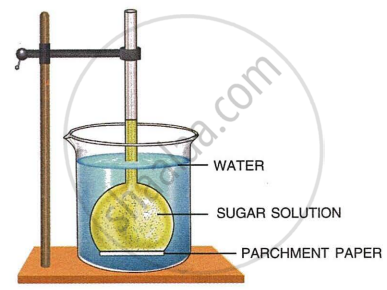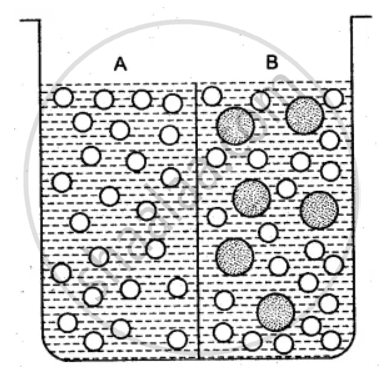Advertisements
Advertisements
प्रश्न
In the figure below ‘A’ shows a cell in the normal state and ‘B’ shows the same cell after leaving it in a certain solution for a few minutes.

(i) Describe the change which has occurred in the cell as seen in B.
(ii) Give the technical term for the condition of the cell as reached in B and as it was in A.
(iii) Define the process which led to this condition.
(iv) What was the solution-isotonic, hypotonic or hypertonic, in which the cell was kept?
(v) How can the cell in B, be brought back to its original condition?
(vi) Name the parts numbered 1 to 3.
उत्तर
(i) Exosmosis (exit of water) has resulted in the shrinkage of the protoplasm of cell B.
(ii) Plasmolysis and deplasmolysis.
(iii) When plant cells are kept in a hypertonic solution, exosmosis takes place. This process is called plasmolysis.
(iv) Hypertonic solution.
(v) The cell in B can be brought back to its original condition by placing it in a drop of distilled water.
(vi) 1. Cell wall, 2. Plasma membrane, 3. Chloroplast.
APPEARS IN
संबंधित प्रश्न
Give two examples of turgor movements in plants.
The diagram given below represents an experimental set-up to demonstrate a certain process. Study the same and answer the questions that follow:

- Name the process.
- Define the above-named process.
- What would you observe in the experimental set-up after an hour or so?
- What control experiment can be set up for comparison?
- Keeping in mind the root hair, cell and its surroundings, name the parts that correspond to
- concentrated sugar solution
- parchment paper
- water in the beaker
- Name any other material that can be used instead of parchment paper in the above experiment.
- Mention two advantages of the process for the plants.
What do you mean by transpiration pull ?
Give Reasons for the following.
On sprinkling common salt on grass growing in a lawn, the grass is killed.
Give Reasons for the following.
We gargle with saline water in case of throat infection.
A plant cell kept in a drop of water was examined under the low power magnification of a microscope, as shown:
(i) What would you do to bring this cell back to its original condition?
(ii) What scientific term is used for such condition?
(iii) Draw the same cell if it is kept in a strong sugar solution.
The beaker is divided into two chambers A and B. The big circle represents solute and the small circles solvent.
(i) What can you say about the size of the holes in the membrane, if it is to behave semi- permeably between these two?
(ii) Will the solvent molecules pass through the membrane from left to right, from right to left, in either direction or in both directions?
(iii) In which direction will there be a net movement of solvent molecules?
Multiple Choice Question:
Plasma membrane controls:
Explain the Term: Exosmosis
